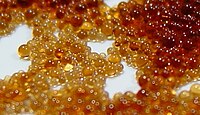
Photo from wikipedia
The presence of metal ions in an aqueous medium is an ongoing challenge throughout the world. Processes employed for metal ion removal are developed continuously with the integration of these… Click to show full abstract
The presence of metal ions in an aqueous medium is an ongoing challenge throughout the world. Processes employed for metal ion removal are developed continuously with the integration of these processes taking center stage. Herein, an integrated system consisting of flocculation, activated carbon (AC), and an ultrafiltration (UF) membrane was assessed for the removal of multiple metal ions contained in wastewater generated from a university chemistry research laboratory. The quality of the wastewater was established before and further determined after treatment with inductively coupled plasma optical emission spectrometry (ICP-OES) for metal content, total dissolved solids (TDS), turbidity, electrical conductivity (EC), and pH. Assessing the spent AC indicated minimal structural changes, indicating a potential for further reuse; for instance, the BET for both the pristine and spent AC exhibited type I isotherms with a mesoporous structure, indicating no major structural changes due to metal complexation. The relative performance of the integrated system indicated that the use of flocculation improved the water quality of metal-laden wastewater for safe disposal. The integrated treatment systems exhibited high removal efficiencies between 80 and 99.99% for all the metal ions except for Mn (<0.008 mg L–1) and Cr (<0.016 mg L–1) both at ca. 70%, indicative of the positive influence of the polyelectrolyte in the treatment process. The fabricated UiO-66-NH2@GO membranes (Z4 and Z5) exhibited high fouling resistance and reusability potential as well as relatively high pure water flux. Consequently, the integrated process employed for the treatment of laboratory metal-containing wastewater is promising as a generic approach to improving the quality of metal-containing wastewater to meet the standards of discharging limits in South Africa.
Journal Title: ACS Omega
Year Published: 2023
Link to full text (if available)
Share on Social Media: Sign Up to like & get
recommendations!